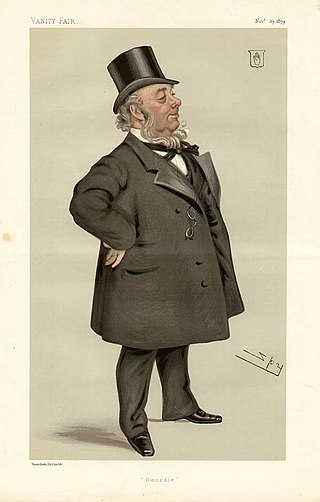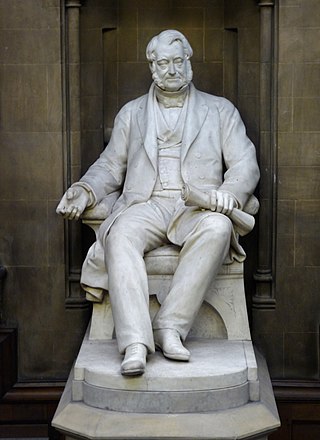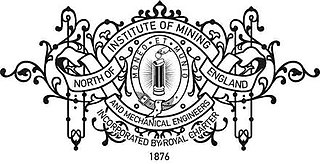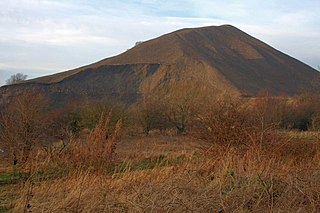Related Research Articles
The American Institute of Mining, Metallurgical, and Petroleum Engineers (AIME) is a professional association for mining and metallurgy, with over 145,000 members. It was founded in 1871 by 22 mining engineers in Wilkes-Barre, Pennsylvania, United States, being one of the first national engineering societies in the country. Its charter is to "advance and disseminate, through the programs of the Member Societies, knowledge of engineering and the arts and sciences involved in the production and use of minerals, metals, energy sources and materials for the benefit of humankind."

Sir George Elliot, 1st Baronet, JP was a mining engineer and self-made businessman from Gateshead in the North-East of England. A colliery labourer who went on to own several coal mines, he later bought a wire rope manufacturing company which manufactured the first Transatlantic telegraph cable. He was also a Conservative Party Member of Parliament (MP).

Sir Richard Augustine Studdert Redmayne was a British civil and mining engineer. Redmayne worked as manager of several mines in Britain and South Africa before becoming a professor at the University of Birmingham. He was a leading figure in improving mine safety in the early twentieth century and would become the first Chief Inspector of Mines, leading investigations into many of the mine disasters of his time. He became the president of three professional associations, namely the Institution of Mining and Metallurgy, the Institution of Professional Civil Servants and the Institution of Civil Engineers.

Nicholas Wood was an English colliery and steam locomotive engineer. He helped engineer and design many steps forward in both engineering and mining safety, and helped bring about the North of England Institute of Mining and Mechanical Engineers, holding the position of President from its inauguration to his death.

The North of England Institute of Mining and Mechanical Engineers (NEIMME), commonly known as The Mining Institute, is a British Royal Chartered learned society and membership organisation dedicated to advancing science and technology in the North and promoting the research and preservation of knowledge relating to mining and mechanical engineering. The membership of the Institute is elected on the basis of their academic and professional achievements with Members and Fellows entitled to the postnominal MNEIMME and FNEIMME. The Institutes’ membership is predominantly from local industry and from academics at Durham and Newcastle Universities, though members are also located further afield across the UK.
Sir William Galloway was a Scottish mining engineer, professor and industrialist.
Robert Lindsay Galloway was a Scottish mining engineer and author, the son of William Galloway (1799–1854), a Paisley shawl manufacturer and coal master and Margaret Lindsay (1818–1902) daughter of Thomas Lindsay, a Glasgow brewer. He was born in Paisley, Scotland
Thomas Lindsay Galloway MA, FRSE. FGS, AMInst, MInstME was the youngest son of William Galloway (1799–1854) shawl manufacturer and coal master of Paisley, Scotland and Margaret Lindsay (1818–1902). He was a civil and mining engineer and coal master of Argyll Colliery, Campbeltown, Kintyre, and like his brothers, Sir William Galloway and Robert Lindsay Galloway, he was also the author of several papers, lectures, designs and books.
George Clementson Greenwell was a British mining engineer.

John Marley was an English mining engineer from Darlington who together with ironmaster John Vaughan made the "commercial discovery" of the Cleveland Ironstone Formation, the basis of the wealth of their company Bolckow Vaughan and the industrial growth of Middlesbrough. He was an effective leader of engineering operations at Bolckow Vaughan's mines and collieries. He ended his career as a wealthy independent mine-owner and president of the North of England Institute of Mining and Mechanical Engineers (NEIMME).
Otto Hinrich ("Henry") Schmill was a German mining engineer who emigrated to England. He was the founder of the Amalgamated Construction Ltd (AMCO) and majority owner of the Tolent Construction Ltd.
Edmund Mills Hann (1850–1931) was a Welsh prominent figure in the industrial life of South Wales, and a leading coal owner during the industrial struggles of the 1920s.

Edward Fenwick Boyd was an English industrialist who became the fourth President of the North of England Institute of Mining and Mechanical Engineers (NEIMME). He held a leading role in the Mining Institute from its inauguration in 1852 as Treasurer and a member of the council before becoming the fourth president in 1869. As president, Boyd oversaw the installation of the Nicholas Wood Memorial Hall and the Newcastle College of Physical Science.
Addison Langhorne Steavenson was an English Mining Engineer. He became President of the North of England Institute of Mining and Mechanical Engineers (NEIMME) in 1893 after being a member of the Institute for thirty-eight years. Steavenson was married to Anna Maria Wilson; they had three daughters named Anna, Frances and Hilda and two sons called Addison Langhorne Junior, who died young, and Charles Herbert Steavenson who went on to become a mining engineer in his own right.
Joseph Parker FRSE MIME (1871–1940) was a Scottish mining engineer and educator.
John Brass was a manager and later director of Houghton Main Colliery Co Ltd. According to the Colliery Year Book and Coal Trades Directory he was "one of the most prominent figures in the South Yorkshire coal mining industry". He held significant posts in the mining, gas and coke industries both in South Yorkshire and nationally. Between 1934 and 1937 he was one of the assessors in the Gresford disaster inquiry and, along with the other assessor, published dissenting reports to the main inquiry.
Wallace ThorneycroftFRSE MIME MISI JP (1864–1954) was a 19th/20th century British mining engineer, businessman, coal-mine owner and geologist. He was President of the Institute of Mining Engineers. As a geologist and archaeologist he was an expert on vitrified forts and one of the first to undertake practical experiments to establish their mode of construction.

Ironstone mining in Cleveland and North Yorkshire occurred on a sizeable scale from the 1830s to the 1960s in present day eastern parts of North Yorkshire but has been recorded as far back as Roman times in mostly a small-scale and intended for local use. This Cleveland is not to be confused with a smaller area covered by the county of Cleveland from 1974-96.
References
- ↑ Companies House
- ↑ Austin, Lawrence (1908). Transactions of the Institution of Mining Engineers vols I to XXX. 1889–1905. p. 3. Retrieved 23 January 2017.
- ↑ "Durham Mining Museum - Henry Copson Peake". www.dmm.org.uk.
- ↑ DMM (30 September 2018). "John Brass". Durham Mining Museum. Retrieved 4 October 2018.